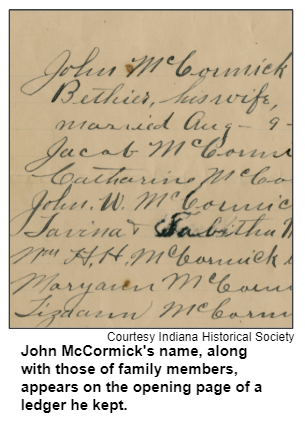Jun 21, 2019

In fact, in June of 1820 McCormick (1791-1825) hosted a meeting to identify the precise site of the new state capital, following an earlier gathering of top state leaders at the cabin of William Conner (namesake of Conner Prairie Interactive History Park.)
Today, a boulder with a commemorative plaque marks the historic site of McCormick's double cabin, which also included a tavern. The site is located in what is now White River State Park.

To share insights about the earliest settlers, Nelson's studio guests are:
- Mike Todd, a retired truck driver who is descended from the McCormicks. Mike, a Ben Davis High School graduate who attended Indiana Central University (now the University of Indianapolis), lives on the west side of the city that his ancestors had such a key role in founding. Mike says that he only developed a passion for the city's history in recent years, although he recalls his grandmother taking him on Memorial Day to visit the commemorative boulder.
- And Jordan Ryan, coordinator of the Indianapolis Bicentennial Project for the Indiana Historical Society. She notes that, as part of a new archival collection for the Bicentennial Project, the society has transcribed the McCormick journal, which was obtained from a descendant who lives in North Carolina. Mike and Jordan persuaded his relative to ship the journal to Indianapolis for transcription.

The historic McCormick journal is now available on the Indiana Historic Society website as a series of high-resolution digital images of each page.
The city's 200th birthday celebrations will extend into 2021 because Scottish-born surveyor Alexander Ralston actually platted the city in 1821, not 1820.
Ralston had helped design the original layout of Washington D.C. and used the plan for the nation's capital as an inspiration for his design of the new Hoosier capital. Hoosier History Live explored Ralston's life and impact during a show in 2013.
According to our guest Mike Todd, Ralston was a guest at John McCormick's tavern. McCormick later built the first sawmill in Marion County.
The McCormicks also ran a ferry service across the White River. "Part of the reason the site near the McCormick cabin was chosen [for the new state capital] was that the White River was seen as navigable and a vital component to the growth of the new city," according to Indianapolis: A Circle City History by Jeffrey Tenuth.

Meanwhile, early pioneer George Pogue vanished without a trace in 1821. The reason for his disappearance never has been determined conclusively.
A wooden table from the original McCormick cabin also vanished. Our guest Mike Todd is on a quest to find the historic table, which was donated to the Indiana State Museum in the 1920s by a McCormick descendant. (The state museum, which has moved twice since then, has said the cherry-wood table has been missing for decades.)
Some other history facts:
- McCormick's Creek State Park in Owen County is named in honor of the McCormick family.
- John McCormick had been a constable in Connersville. Pogue had been a blacksmith there.
- The 200th birthday celebrations are being organized by a bipartisan Indianapolis Bicentennial Commission co-chaired by former mayors Greg Ballard and Bart Peterson.